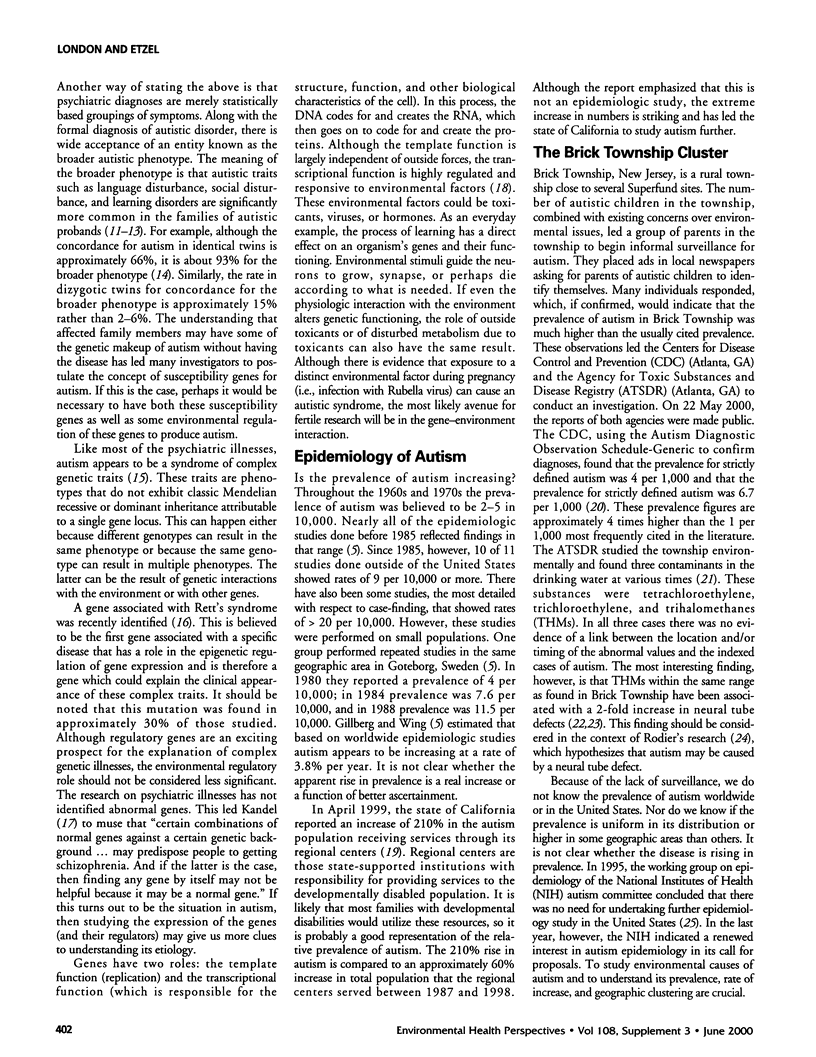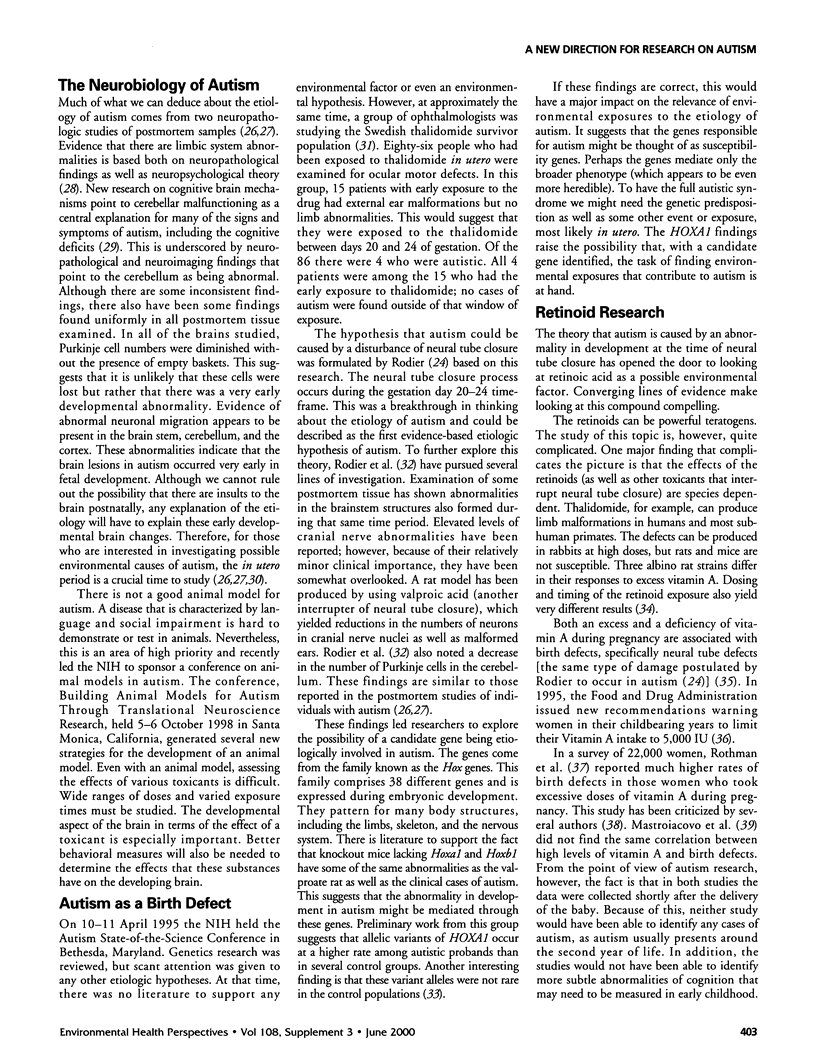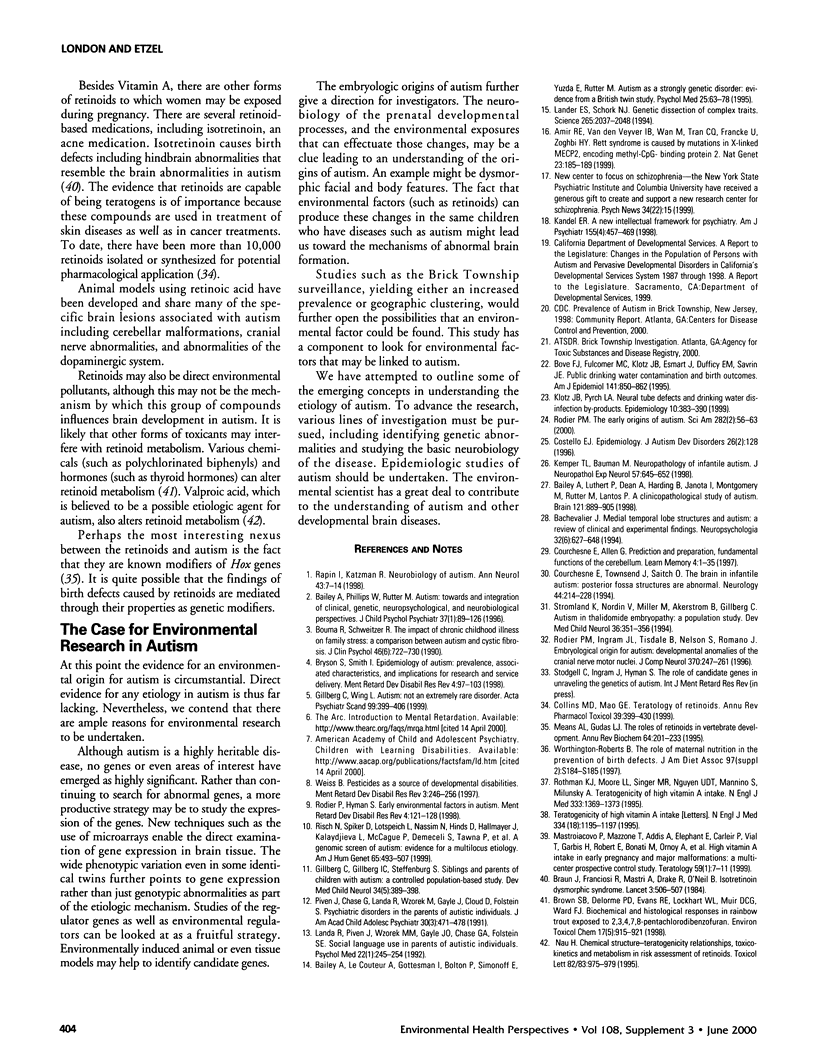Abstract
Autism is one of a group of developmental disorders that have devastating lifelong effects on its victims. Despite the severity of the disease and the fact that it is relatively common (15 in 10,000), there is still little understanding of its etiology. Although believed to be highly genetic, no abnormal genes have been found. Recent findings in autism and in related disorders point to the possibility that the disease is caused by a gene-environment interaction. Epidemiologic studies indicate that the number of cases of autism is increasing dramatically each year. It is not clear whether this is due to a real increase in the disease or whether this is an artifact of ascertainment. A new theory regarding the etiology of autism suggests that it may be a disease of very early fetal development (approximately day 20-24 of gestation). This theory has initiated new lines of investigation into developmental genes. Environmental exposures during pregnancy could cause or contribute to autism based on the neurobiology of these genes.
Full text
PDF



Selected References
These references are in PubMed. This may not be the complete list of references from this article.
- Amir R. E., Van den Veyver I. B., Wan M., Tran C. Q., Francke U., Zoghbi H. Y. Rett syndrome is caused by mutations in X-linked MECP2, encoding methyl-CpG-binding protein 2. Nat Genet. 1999 Oct;23(2):185–188. doi: 10.1038/13810. [DOI] [PubMed] [Google Scholar]
- Bachevalier J. Medial temporal lobe structures and autism: a review of clinical and experimental findings. Neuropsychologia. 1994 Jun;32(6):627–648. doi: 10.1016/0028-3932(94)90025-6. [DOI] [PubMed] [Google Scholar]
- Bailey A., Le Couteur A., Gottesman I., Bolton P., Simonoff E., Yuzda E., Rutter M. Autism as a strongly genetic disorder: evidence from a British twin study. Psychol Med. 1995 Jan;25(1):63–77. doi: 10.1017/s0033291700028099. [DOI] [PubMed] [Google Scholar]
- Bailey A., Luthert P., Dean A., Harding B., Janota I., Montgomery M., Rutter M., Lantos P. A clinicopathological study of autism. Brain. 1998 May;121(Pt 5):889–905. doi: 10.1093/brain/121.5.889. [DOI] [PubMed] [Google Scholar]
- Bailey A., Phillips W., Rutter M. Autism: towards an integration of clinical, genetic, neuropsychological, and neurobiological perspectives. J Child Psychol Psychiatry. 1996 Jan;37(1):89–126. doi: 10.1111/j.1469-7610.1996.tb01381.x. [DOI] [PubMed] [Google Scholar]
- Bouma R., Schweitzer R. The impact of chronic childhood illness on family stress: a comparison between autism and cystic fibrosis. J Clin Psychol. 1990 Nov;46(6):722–730. doi: 10.1002/1097-4679(199011)46:6<722::aid-jclp2270460605>3.0.co;2-6. [DOI] [PubMed] [Google Scholar]
- Bove F. J., Fulcomer M. C., Klotz J. B., Esmart J., Dufficy E. M., Savrin J. E. Public drinking water contamination and birth outcomes. Am J Epidemiol. 1995 May 1;141(9):850–862. doi: 10.1093/oxfordjournals.aje.a117521. [DOI] [PubMed] [Google Scholar]
- Braun J. T., Franciosi R. A., Mastri A. R., Drake R. M., O'Neil B. L. Isotretinoin dysmorphic syndrome. Lancet. 1984 Mar 3;1(8375):506–507. doi: 10.1016/s0140-6736(84)92866-6. [DOI] [PubMed] [Google Scholar]
- Collins M. D., Mao G. E. Teratology of retinoids. Annu Rev Pharmacol Toxicol. 1999;39:399–430. doi: 10.1146/annurev.pharmtox.39.1.399. [DOI] [PubMed] [Google Scholar]
- Courchesne E., Allen G. Prediction and preparation, fundamental functions of the cerebellum. Learn Mem. 1997 May-Jun;4(1):1–35. doi: 10.1101/lm.4.1.1. [DOI] [PubMed] [Google Scholar]
- Courchesne E., Townsend J., Saitoh O. The brain in infantile autism: posterior fossa structures are abnormal. Neurology. 1994 Feb;44(2):214–223. doi: 10.1212/wnl.44.2.214. [DOI] [PubMed] [Google Scholar]
- Gillberg C., Wing L. Autism: not an extremely rare disorder. Acta Psychiatr Scand. 1999 Jun;99(6):399–406. doi: 10.1111/j.1600-0447.1999.tb00984.x. [DOI] [PubMed] [Google Scholar]
- Kandel E. R. A new intellectual framework for psychiatry. Am J Psychiatry. 1998 Apr;155(4):457–469. doi: 10.1176/ajp.155.4.457. [DOI] [PubMed] [Google Scholar]
- Kemper T. L., Bauman M. Neuropathology of infantile autism. J Neuropathol Exp Neurol. 1998 Jul;57(7):645–652. doi: 10.1097/00005072-199807000-00001. [DOI] [PubMed] [Google Scholar]
- Klotz J. B., Pyrch L. A. Neural tube defects and drinking water disinfection by-products. Epidemiology. 1999 Jul;10(4):383–390. doi: 10.1097/00001648-199907000-00005. [DOI] [PubMed] [Google Scholar]
- Landa R., Piven J., Wzorek M. M., Gayle J. O., Chase G. A., Folstein S. E. Social language use in parents of autistic individuals. Psychol Med. 1992 Feb;22(1):245–254. doi: 10.1017/s0033291700032918. [DOI] [PubMed] [Google Scholar]
- Lander E. S., Schork N. J. Genetic dissection of complex traits. Science. 1994 Sep 30;265(5181):2037–2048. doi: 10.1126/science.8091226. [DOI] [PubMed] [Google Scholar]
- Mastroiacovo P., Mazzone T., Addis A., Elephant E., Carlier P., Vial T., Garbis H., Robert E., Bonati M., Ornoy A. High vitamin A intake in early pregnancy and major malformations: a multicenter prospective controlled study. Teratology. 1999 Jan;59(1):7–11. doi: 10.1002/(SICI)1096-9926(199901)59:1<7::AID-TERA4>3.0.CO;2-6. [DOI] [PubMed] [Google Scholar]
- Means A. L., Gudas L. J. The roles of retinoids in vertebrate development. Annu Rev Biochem. 1995;64:201–233. doi: 10.1146/annurev.bi.64.070195.001221. [DOI] [PubMed] [Google Scholar]
- Nau H. Chemical structure--teratogenicity relationships, toxicokinetics and metabolism in risk assessment of retinoids. Toxicol Lett. 1995 Dec;82-83:975–979. doi: 10.1016/0378-4274(95)03624-5. [DOI] [PubMed] [Google Scholar]
- Rapin I., Katzman R. Neurobiology of autism. Ann Neurol. 1998 Jan;43(1):7–14. doi: 10.1002/ana.410430106. [DOI] [PubMed] [Google Scholar]
- Risch N., Spiker D., Lotspeich L., Nouri N., Hinds D., Hallmayer J., Kalaydjieva L., McCague P., Dimiceli S., Pitts T. A genomic screen of autism: evidence for a multilocus etiology. Am J Hum Genet. 1999 Aug;65(2):493–507. doi: 10.1086/302497. [DOI] [PMC free article] [PubMed] [Google Scholar]
- Rodier P. M., Ingram J. L., Tisdale B., Nelson S., Romano J. Embryological origin for autism: developmental anomalies of the cranial nerve motor nuclei. J Comp Neurol. 1996 Jun 24;370(2):247–261. doi: 10.1002/(SICI)1096-9861(19960624)370:2<247::AID-CNE8>3.0.CO;2-2. [DOI] [PubMed] [Google Scholar]
- Rodier P. M. The early origins of autism. Sci Am. 2000 Feb;282(2):56–63. doi: 10.1038/scientificamerican0200-56. [DOI] [PubMed] [Google Scholar]
- Rothman K. J., Moore L. L., Singer M. R., Nguyen U. S., Mannino S., Milunsky A. Teratogenicity of high vitamin A intake. N Engl J Med. 1995 Nov 23;333(21):1369–1373. doi: 10.1056/NEJM199511233332101. [DOI] [PubMed] [Google Scholar]
- Strömland K., Nordin V., Miller M., Akerström B., Gillberg C. Autism in thalidomide embryopathy: a population study. Dev Med Child Neurol. 1994 Apr;36(4):351–356. doi: 10.1111/j.1469-8749.1994.tb11856.x. [DOI] [PubMed] [Google Scholar]
- Worthington-Roberts B. The role of maternal nutrition in the prevention of birth defects. J Am Diet Assoc. 1997 Oct;97(10 Suppl 2):S184–S185. doi: 10.1016/s0002-8223(97)00760-8. [DOI] [PubMed] [Google Scholar]


